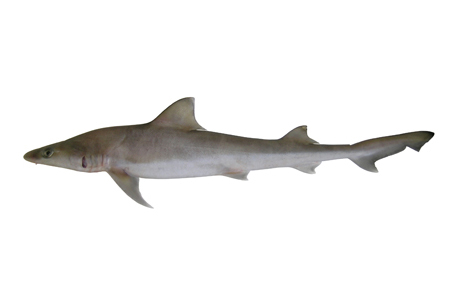- Classification
- CHONDRICHTHYES
- CARCHARHINIFORMES
- HEMIGALEIDAE
- Hemigaleus
- australiensis
Weasel Shark, Hemigaleus australiensis White, Last & Compagno 2005
Other Names: Australian Weasel Shark, Sickelfin Weasel Shark

A Weasel Shark, Hemigaleus australiensis. Source: CSIRO National Fish Collection. License: CC BY Attribution
Summary:
A medium-sized greyish to bronze shark with a pale underside, a conspicuous dark tip on the second dorsal fin, and a pale posterior margin on the first dorsal fin.
This species was previously known as Hemigaleus microstoma.
This species was previously known as Hemigaleus microstoma.
Cite this page as:
Dianne J. Bray, Hemigaleus australiensis in Fishes of Australia, accessed 07 Apr 2025, https://fishesofaustralia.net.au/home/species/3258
Weasel Shark, Hemigaleus australiensis White, Last & Compagno 2005
More Info
|
Distribution |
Geraldton, Western Australia, to Brunswick Heads, New South Wales; also southern Papua New Guinea. Inhabits insular and continental shelves from inshore bays to depths of 170 m. |
|
Features |
No interdorsal ridge; second dorsal fin at least half the height of the first dorsal fin; second dorsal-fin origin much closer to the anal fin-origin than to the free rear tips of the pelvic fins. Upper jaw teeth with one edge coarsely-serrated (comb-like), and the other edge smooth; notch present at rear corner of each almond-shaped eye; spiracles present. Medium-sized shark with moderately long head; dorsal fins slightly raked back, moderately or not falcate, moderately low; height of first dorsal fin 2.6-3 in head length (HL); length of first dorsal fin 2.1-2.4 times its height; caudal-fin upper lobe moderately broad, not elongate; caudal-fin ventral lobe short, preventral margin 9.3-9.8% TL; pectoral fins broad, falcate, base length 2.1-2.4 in preventral caudal margin. Claspers of adults moderately short, inner length 5.4-5.6% TL, 1.8-1.8 in pelvic midpoint to first dorsal-fin insertion. Teeth in 28-30/46-52 rows; precaudal vertebral centra 65-70, total vertebral centra 112-121. |
|
Biology |
Males attain sexual maturity at about 60 cm TL; females at 60-65 cm TL. The young are born at about 30 cm TL. |
|
Fisheries |
Although commonly caught in prawn and fish trawl fisheries, and in gillnet and longline fisheries, the species is not taken in large numbers. |
|
Etymology |
The species is named australiensis in reference to the its geographic range off tropical Australia. |
|
Species Citation |
Hemigaleus australiensis White, Last & Compagno 2005, Zootaxa 1077: 40, fig. 1. Type locality: north-west of Geraldton, WA. |
|
Author |
Dianne J. Bray |
|
Resources |
Weasel Shark, Hemigaleus australiensis White, Last & Compagno 2005
References
Blaber, S.J.M., Brewer, D.T. & Harris, A.N. 1994. Distribution, biomass and community structure of demersal fishes of the Gulf of Carpentaria, Australia. Aust. J. Mar. Freshwat. Res. 45(3): 375-396. (as Hemigaleus microstoma)
Compagno, L.J.V. 1984. FAO Species Catalogue. Sharks of the World. An annotated and illustrated catalogue of shark species known to date. Carcharhiniformes. FAO Fisheries Synopsis No. 125. Rome : FAO Vol. 4(2) 251-655 pp. (as Hemigaleus microstoma)
Compagno, L.J.V. 1998. Family Hemigaleidae. pp. 1305-1311 in Carpenter, K.E. & Niem, V.H. (eds) The Living Marine Resources of the Western Central Pacific. FAO Species Identification Guide for Fisheries Purposes. Rome : FAO Vol. 2 687-1396 pp. (as Hemigaleus sp. microstoma)
Compagno, L.J.V., Dando, M. & Fowler, S. 2005. A Field Guide to the Sharks of the World. London : Collins 368 pp. (as Hemigaleus sp. A)
Johnson, J.W. 2010. Fishes of the Moreton Bay Marine Park and adjacent continental shelf waters, Queensland, Australia. pp. 299-353 in Davie, P.J.F. & Phillips, J.A. Proceedings of the Thirteenth International Marine Biological Workshop, The Marine Fauna and Flora of Moreton Bay. Memoirs of the Queensland Museum 54(3)
Last, P.R. & Stevens, J.D. 1994. Sharks and Rays of Australia. Canberra : CSIRO Australia 513 pp. 84 pls (as Hemigaleus microstoma)
Last, P.R. & Stevens, J.D. 2009. Sharks and Rays of Australia. Collingwood : CSIRO Publishing Australia 2, 550 pp.
Macbeth, W.G., Vandenberg, M. & Graham, K.J. 2008. Identifying Sharks and Rays; A guide to Commercial Fishers. Sydney : New South Wales Department of Primary Industry pp. 71.
Sainsbury, K.J., Kailola, P.J. & Leyland, G.G. 1984. Continental Shelf Fishes of Northern and North-Western Australia. Canberra : Fisheries Information Service 375 pp. figs & pls. (as Hemigaleus microstoma)
Salini, J.P., Blaber, S.J. & Brewer, D.T. 1992. Diets of sharks from estuaries and adjacent waters of the north-eastern Gulf of Carpentaria, Australia. Aust. J. Mar. Freshwat. Res. 43(1): 87-96. (as Hemigaleus microstoma)
Simpfendorfer, C., White, W.T. & Smart, J.J. 2016. Hemigaleus australiensis. The IUCN Red List of Threatened Species 2016: e.T161539A68624897. http://dx.doi.org/10.2305/IUCN.UK.2016-1.RLTS.T161539A68624897.en. Downloaded on 05 September 2016.
White, W.T., Last, P.R. & Compagno, L.J.V. 2005. Description of a new species of weasel shark, Hemigaleus australiensis n. sp. (Carcharhiniformes: Hemigaleidae) from Australian waters. Zootaxa 1077: 37-49.
Whitley, G.P. 1940. The Fishes of Australia. Part 1. The sharks, rays, devil-fish, and other primitive fishes of Australia and New Zealand. Sydney : Roy. Zool. Soc. N.S.W. 280 pp. 303 figs. (as Negogaleus microstoma)
Yates, P.M. & Heupel, M.R. & Tobon, A.J. & Moore, S.K. & Simpfendorfer, C.A. (2015) Diversity in immature-shark communities along a tropical coastline. Marine and Freshwater Research 66 (5): 399-410 DOI: 10.1071/MF14033 Abstract

